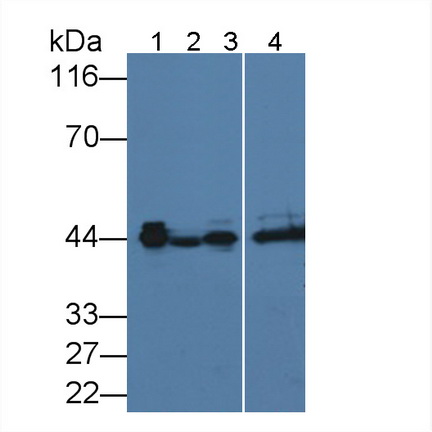Monoclonal Antibody to Alpha-2-Glycoprotein 1, Zinc Binding (aZGP1) 

ZA2G; ZAG
- UOM
- FOB US$ 134.00 US$ 312.00 US$ 445.00 US$ 1,113.00 US$ 4,450.00
- Quantity
Overview
Properties
- Product No.MAL231Ra24
- Organism SpeciesRattus norvegicus (Rat) Same name, Different species.
- ApplicationsWB
If the antibody is used in flow cytometry, please check FCM antibodies.
Research use only - DownloadInstruction Manual
- CategoryMetabolic pathway
- SourceMonoclonal antibody preparation, Host Mouse
- Ig Isotype IgG2b Kappa, Clone Number C9
- PurificationProtein A + Protein G affinity chromatography
- LabelNone
- Immunogen RPL231Ra01-Recombinant Alpha-2-Glycoprotein 1, Zinc Binding (aZGP1)
- Buffer Formulation0.01M PBS, pH7.4, containing 0.05% Proclin-300, 50% glycerol.
- TraitsLiquid, Concentration 1mg/ml
Sign into your account
Share a new citation as an author
Upload your experimental result
Review

Contact us
Please fill in the blank.
Specifity
The antibody is a mouse monoclonal antibody raised against aZGP1. It has been selected for its ability to recognize aZGP1 in immunohistochemical staining and western blotting.
Usage
Western blotting: 0.01-5µg/mL;
Optimal working dilutions must be determined by end user.
Storage
Store at 4°C for frequent use. Stored at -20°C in a manual defrost freezer for two year without detectable loss of activity. Avoid repeated freeze-thaw cycles.
Stability
The thermal stability is described by the loss rate. The loss rate was determined by accelerated thermal degradation test, that is, incubate the protein at 37°C for 48h, and no obvious degradation and precipitation were observed. The loss rate is less than 5% within the expiration date under appropriate storage condition.
Giveaways
Increment services
-
 Antibody Labeling Customized Service
Antibody Labeling Customized Service
-
 Protein A/G Purification Column
Protein A/G Purification Column
-
 Staining Solution for Cells and Tissue
Staining Solution for Cells and Tissue
-
 Positive Control for Antibody
Positive Control for Antibody
-
 Tissue/Sections Customized Service
Tissue/Sections Customized Service
-
 Phosphorylated Antibody Customized Service
Phosphorylated Antibody Customized Service
-
 Western Blot (WB) Experiment Service
Western Blot (WB) Experiment Service
-
 Immunohistochemistry (IHC) Experiment Service
Immunohistochemistry (IHC) Experiment Service
-
 Immunocytochemistry (ICC) Experiment Service
Immunocytochemistry (ICC) Experiment Service
-
 Flow Cytometry (FCM) Experiment Service
Flow Cytometry (FCM) Experiment Service
-
 Immunoprecipitation (IP) Experiment Service
Immunoprecipitation (IP) Experiment Service
-
 Immunofluorescence (IF) Experiment Service
Immunofluorescence (IF) Experiment Service
-
 Buffer
Buffer
-
 DAB Chromogen Kit
DAB Chromogen Kit
-
 SABC Kit
SABC Kit
-
 Long-arm Biotin Labeling Kit
Long-arm Biotin Labeling Kit
-
 Real Time PCR Experimental Service
Real Time PCR Experimental Service
Citations
- Identification of plasma Complement C3 as a potential biomarker for neuroblastoma using a quantitative proteomic approachScienceDirect: S1874391913005472
- Serum ZAG Levels Were Associated with eGFR Mild Decrease in T2DM Patients with Diabetic Nephropathy.pubmed:28352283
- Quantitative Proteomic Analyses of Tear Fluid in Graves' OrbitopathyISBN 978-82-8377-114-5
- Circulating and Adipose Tissue mRNA Levels of Zinc-α2-Glycoprotein, Leptin, High-Molecular-Weight Adiponectin, and Tumor Necrosis Factor-Alpha in …Pubmed:29755407
- Serum Zinc-α2-Glycoprotein Levels in Patients with or without Coronary Artery Disease in Chinese North PopulationPubmed: 32184822
- Low Serum ZAG Levels Correlate With Determinants of the Metabolic Syndrome in Chinese SubjectsPubmed: 32265843
- Serum ZAG and Adiponectin Levels Were Closely Related to Obesity and the Metabolically Abnormal Phenotype in Chinese PopulationPubmed: 32904655
- A study on serum pro-neurotensin (PNT), furin, and zinc alpha-2-glycoprotein (ZAG) levels in patients with acromegalyPubmed:35670958






